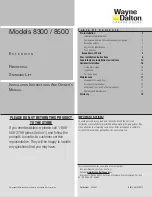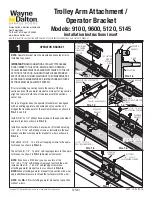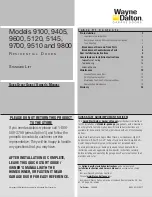
Do likewise for the other magnet.
Take the gate to about halfway of its travel and relock the system (see
paragraph 9).
Before sending a pulse, make sure that the gate cannot be moved
manually.
Command a complete gate cycle to check if the travel-limit device is
tripping correctly.
To avoid damaging the operator and/or interrupting operation of the
automated system, leave a distance of least 40 mm from the travel limit
mechanical stops.
Make sure that at the end of both the opening and closing manoeuvre, the
relevant travel-limit LED stays active (LED OFF).
Make the appropriate modifications to the positions of the travel-limit
magnets.
7. AUTOMATED SYSTEM TEST
Fit the lateral protective devices and re-position the motor cover, securing
it with the appropriate screws (Fig. 19).
Apply the danger sticker on the top of
the cover (Fig. 20).
Check operating efficiency of the
automated system and all accessories
connected to it.
Hand the “Use Instructions” to the Cus-
tomer, explain correct operation and
use of the gearmotor, and indicate the
potentially dangerous areas of the automated system.
8. MANUAL OPERATION
The manual release is a device that makes it possible to disconnect the
operator from the gate, thus enabling manual movement.
Before using the release device, cut power to the system, with the
differential switch upstream of the gearmotor.
THE RELEASE DEVICE MUST NOT BE CONSIDERED AN EMERGENCY STOP
If the gate has to be moved manually due to a power cut or fault of the
automated system, use the release device as follows:
1. Fit the supplied key in the lock, Fig. 21 Ref.
, and turn it clockwise as
shown in Fig. 21 Ref.
.
2. Turn the release system clockwise by about 180°, as shown in Fig. 21 Ref.
.
3. Open and close the gate manually.
9. RESTORING NORMAL OPERATION MODE
To prevent an involuntary pulse from activating the gate during the manoeu-
vre, cut power to the system before re-locking the operator.
1. Turn the release system anti-clockwise by about 180°, as shown in Fig. 22
ref.
.
2. Turn the key anti-clockwise, Fig. 22 ref.
, and remove it from the lock, as
shown in Fig. 22 ref.
.
3. Move the gate until it meshes to release.
Before powering up the system again, make sure that the gate cannot
be moved manually.
10. SPECIAL APPLICATIONS
There are no special applications.
Anything not expressly specified in these instructions is expressly pro-
hibited
11. MAINTENANCE
To ensure correct long-term operation and a constant level of safety, we
advise you to generally control the system every 6 months. In the “Use In-
structions” booklet, there is a form for recording maintenance jobs.
The enclosed maintenance form is purely a guideline; it cannot be ruled
out that to guarantee a correctly operating automated system and
a constant level of safety, maintenance operations not described in
this form may be necessary.
12. REPAIRS
The User must not in any way attempt to repair or to take direct action and
must solely contact qualified GENIUS personnel or GENIUS service centres.
13. ACCESSORIES
For accessories, see the GENIUS catalogue.
Fig. 18
Fig. 19
Fig. 20
Fig. 21
Fig. 22
FALCON M
10
00058I0616 - Rev.1
Tr
ansla
tion of the original instruc
tions
ENGLISH
Содержание falcon m
Страница 1: ...FALCON M...
Страница 26: ...FALCON M_Utente 8 00058I0616 Rev 1...
Страница 41: ...FALCON M_Utente 8 00058I0616 Rev 1...
Страница 42: ...FALCON M_Utente 8 00058I0616 Rev 1...













































